How to hire remote engineers like inVision, GitLab and Automattic do?
Where do the talented developers dwell? (Spoiler alert: Everywhere)
In the case of penguins or the tsetse fly, we know exactly in what regions on the map they populate. Talented developers, however, are not tied to temperature and humidity levels — they are almost everywhere.
To highlight the most popular locations for remote hiring, we used the list of established remote tech companies compiled by Yanir Seroussi, a Data Scientist at Automattic, as the basis for our report. As an illustration as to why this list is a good example, here is an eloquent tweet about some companies from this list.
All data and links are current, as of December the 20th, 2019.
Our Partners

You probably know these companies and you surely want your company to be like them. We are not undertaking to disclose the secrets of their success, but have decided to answer at least one question: where do these companies go to hire developers? After all, the success of any company is based on the talent of the people who make it up.
In our view, remote companies are the most advanced and progressive. The courage to hire remotely is directly correlated with their commitment to relatively fresh trends, such as the primacy of culture in the company and the real diversity within it. Then we decided to find out in which countries distributed companies prefer to hire specialists and, as a follow-up, what advantages some companies get out of the comfort zone of the United States.
We analyzed LinkedIn profiles of Established remote companies and find out where they hire the most in-demand employees — engineers, which hub countries have become kind of expected, and which are not obvious, but favorable hiring locations.
Welcome to our data-results.
Disclaimer
Take into account that
we analyzed only those employee profiles where Software Developer or Engineer is specified as a specialization;
not all developers of these companies have an account on LinkedIn;
not all of them regularly update their profile information;
not everyone specifies their real place of residence; employees often choose the city where the company is registered.
Despite some unavoidable inaccuracies, the data can be considered indicative.
Remote friendly companies by valuation
@redhat sold $34B
@github sold $7.5B
@elastic > $5B
@automattic > $3B
@gitlab > $2.7B
@confluentinc > $2.5B
@monzo > $2.5B
@InVisionApp > $2B
@Upwork > $1.2B
@auth0 > $1B
@digitalocean > $500M
Any other fast-growing remote startups?
@redhat sold $34B
@github sold $7.5B
@elastic > $5B
@automattic > $3B
@gitlab > $2.7B
@confluentinc > $2.5B
@monzo > $2.5B
@InVisionApp > $2B
@Upwork > $1.2B
@auth0 > $1B
@digitalocean > $500M
Any other fast-growing remote startups?

169
4:17 PM - Dec 10, 2019



We selected 9768 software engineers of established remote companies and analyzed the available data about them. It turned out that 41.4% of these developers live and work in the United States and 58.6% are scattered around other parts of the world.
Looking at the first chart, there is a great temptation to make a sudden conclusion — "Obviously, the best way is to hire from the US, I knew it!"
Let's ask a rather naive question: why is hiring in the U.S. so outweighed?
The following explanations seem to help explain the disparity:
76% of the founders of the companies from the list live in the United States.
Hiring in a company usually begins within the network of its founders and the network has a certain range of action within the country.
Not many companies prefer an asynchronous work format and working synchronously is easier in relative proximity and within one time zone.
Most importantly, American founders are convinced that the best developers are American developers.
We do not want to argue with the last thesis, but we hope to open some minds and insist that talent is distributed everywhere. Otherwise, what would these companies do without half (58.6%) of their employees?
Where do established remote companies hire software engineers?
We want to understand the trends of remote hiring through the example of a relatively small sample of established remote companies, which can be extrapolated to the IT market in general, and have identified the 15 most popular countries after the United States, where engineers from established remote companies work:
The remaining 21.35% of engineers are dispersed all over from the Dominican Republic and Pakistan out to Japan.
2−5% of employees in the sample by country are as important as a 2−5% increase in company profits. This may seem insignificant until translated into real numbers.
Why hiring outside the United States is cool and why this has become the new trend is obvious to anyone who has tried to find developers for their project there. But how can you choose a country out of the 251 available? Where do you look and how do you even start? Let’s try to answer this question together based on the numbers and your priorities in hiring.
of software engineers in established remote companies are not from the United States.

6nomads blog

companies on the list don't hire engineers outside the US: Trello, Jackson River, Olark.

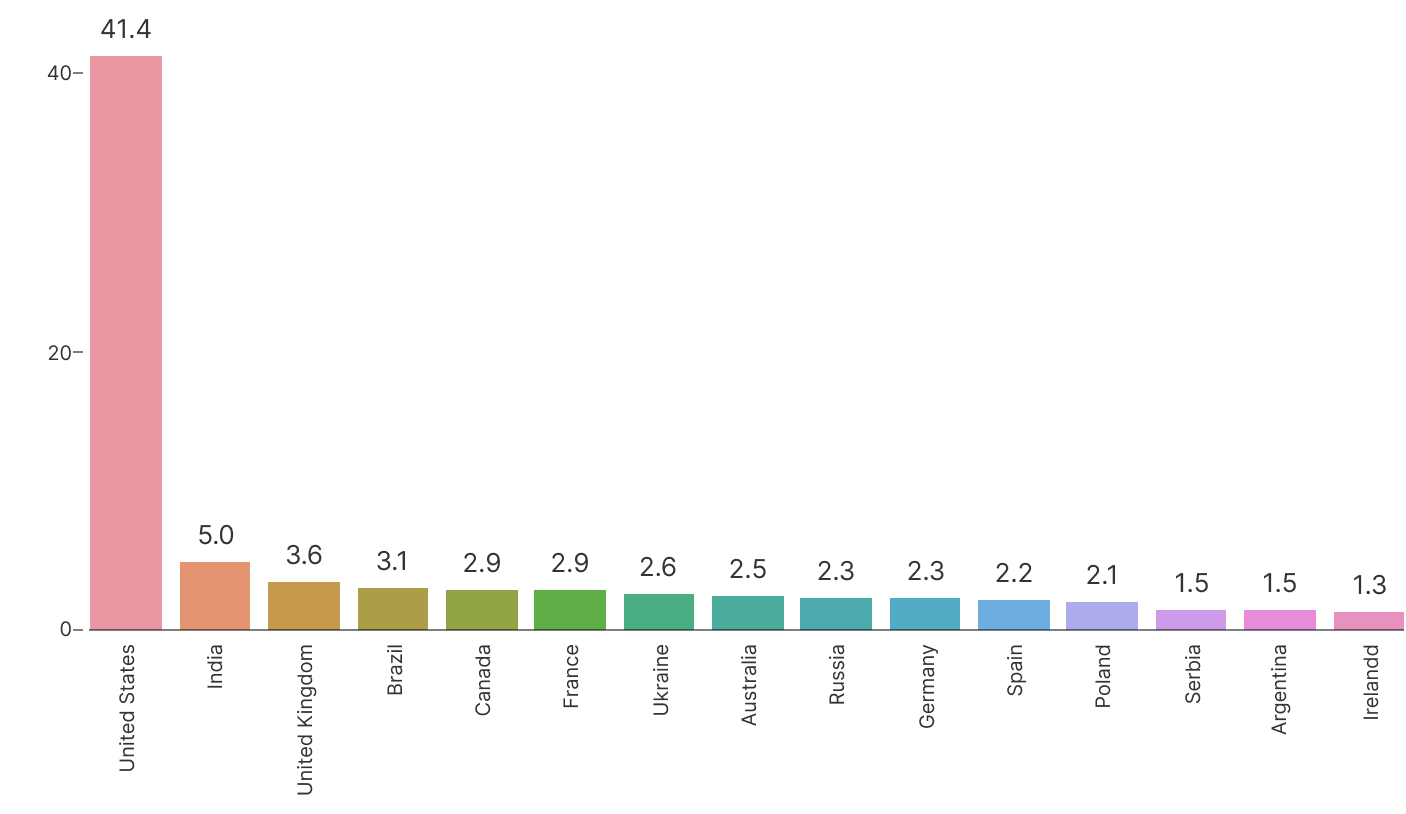
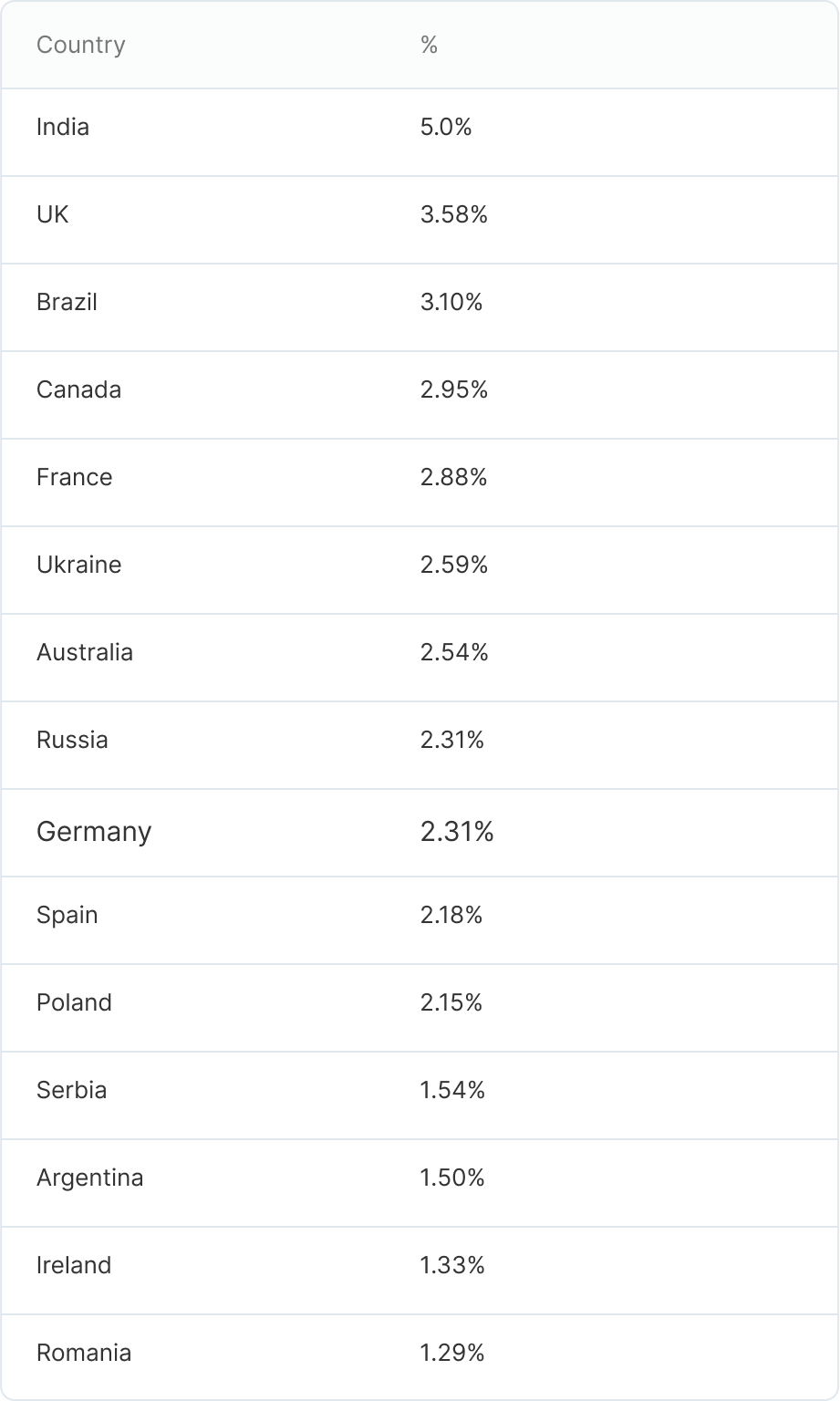
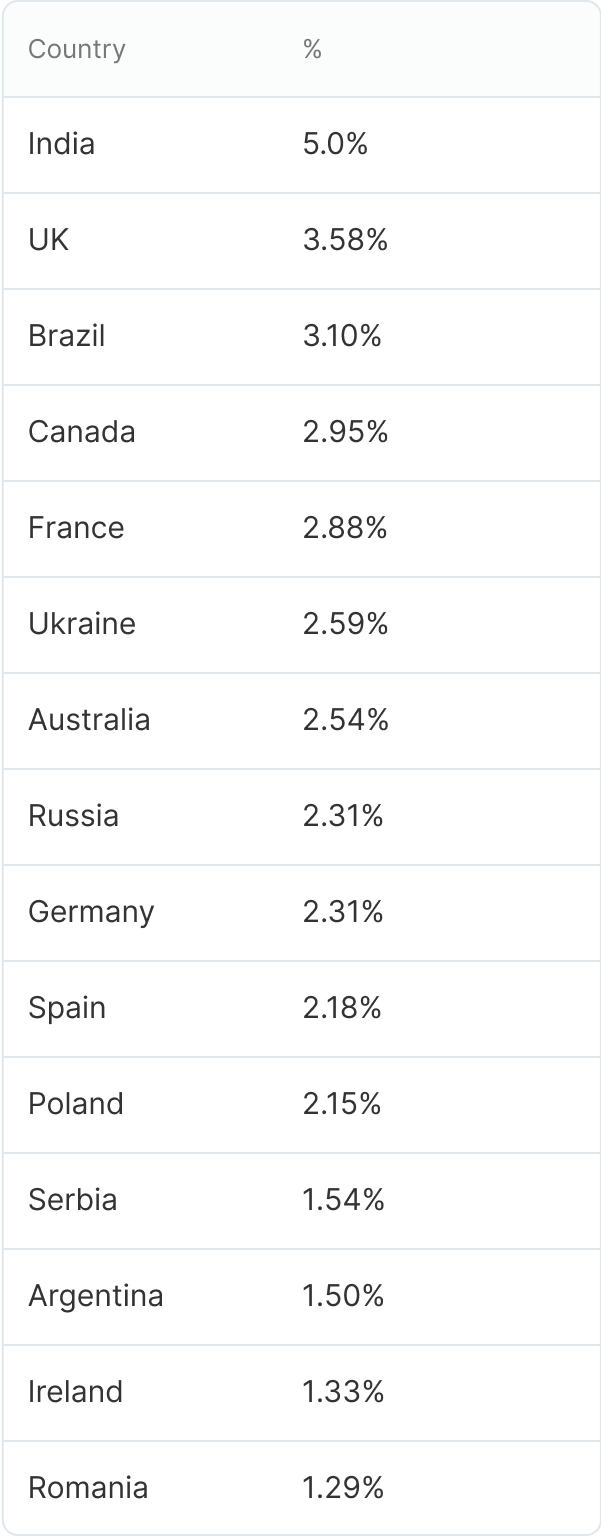

If you hire remotely you have to care about the following factors: timezone, salary, culture fit, English proficiency, competitive environment.
Time zones: Most of the established remote companies work asynchronously
Time zone is a criterion that is difficult to ignore during the hiring process; time zones and their spread affect the management style and communication system. Therefore, first of all, you have to decide: do you prefer synchronous work or are you ready to move to a new level and build asynchronous communication in the company. This means committing to being timezone-sacral or timezone-agnostic. Both approaches have their pros and cons and your choice should be based on the needs of your company and its characteristics.
It leads to constant interruptions.
It prioritizes being connected over being productive.
It creates unnecessary stress.
It leads to lower quality discussions and suboptimal solutions.
Doist simplifies the explanation of the two work styles down to this: "Asynchronous communication is when you send a message without expecting an immediate response. In contrast, synchronous communication is when you send a message and the recipient processes the information and responds immediately."
What are the important priorities to consider when hiring employees from other countries?
In the same article Doist highlights the following core problems of synchronous team communication:
In addition to strong management, stock up on the most convenient tools.
A tool like Miro is very powerful for us because it allows to exchange ideas together, plan and work out ideas. So it's a very good like visual obviating, too. It's also great for asynchronous work. Miro as a tool allows both to be in very real time to see this visual kind of artifacts coming to life and you can interact with them. But then the collaboration functions allow really great asynchronous work as well. So, we found that pairing Miro with Zoom, in particular, has been very powerful.
A
On the other side Vivek Nair, the founder of Pragli, gave 3 reasons why too much asynchronous communication could lead to frustration:
Too much asynchronous communication can hurt company culture.
New hires onboard best synchronously.
Engineering is an iterative and collaborative process, therefore a dose of impromptu synchronous communication can create tighter collaboration loops, help to resolve issues faster and get back to focus time.
Everyone is right, yet, as always, there is a good balance is in the middle. Asynchronous work erases the boundaries of hiring, gives more freedom to employees, allows everyone to choose productive work hours, limits communication to the most productive and valuable needs. At the same time, it requires a more refined management structure, a strong culture and motivation within the company, mature specialists, competent task distribution, to ensure that engineers don’t need to wait for work or confirmation from their colleagues who are already in bed — without a lot of controls, async just won’t work. But asynchronous work is the only possible, and at the same time, absolutely humane option for a 24/7 operation, to get faster releases and always be in touch with customers.

Once we’ve had sixty five people on a single Miro board planning our company strategy together.
Head of Brand at Over

Your company can work literally



without resorting to cloning
The average salary in the region: If you pay peanuts, you get monkeys
In the first two columns, we calculated the average salary for middle and senior developers using resources such as PayScale and Salaryexpert while focusing on the capitals of these countries.
Although the calculator defines the Location Factor as 0.411 for Serbia, Argentina and Bangladesh and 0.392 or 0.403 for some regions of the UK, which looks absolutely implausible while the cost of living differs many times with the odds on the UK side.
B
GitLab did the same and created a calculator of their own. The formula is SF benchmark x Location Factor x Level Factor x Compa Ratio x Contract Factor x Exchange Rate. In the second two columns we used this popular calculator.
Large differences in average wages

Countries where GitLab does not hire
However, we want to warn you against delusions: do not think that hiring remote employees is just about extreme cost cutting. As The Remote Work ROI Calculator V0.95 can obviously show you, it does cut costs, however, getting a qualified developer from a country with a low cost of living for their average local salary is no longer possible. If you pay peanuts, you get monkeys. PayScale data shows that remote workers actually earn more than their physical commuter counterparts.
We have two potential explanations for this phenomenon.

Second, allowing an employee to telecommute requires a certain amount of trust. Telecommuters are more experienced or more skilled at their jobs, and therefore more valuable to their organization, resulting in a highly paid cohort of telecommuters.
Data Analyst at PayScale
First, companies that allow telecommuting are generally more progressive in their managerial practices and offer relatively high pay. Many tech companies would fit into this category. If most people who can telecommute work at these companies, we would expect their pay to be higher.
These workers are becoming more and more experienced, and more and more in-demand. They know this. Times change and remote hiring is changing, too. This does not mean that the dependence on the average salary in the country of employment and the standard of living there has disappeared altogether. Buffer came up with their own system for calculating fair pay for employees taking into account the cost of living and the level of the engineer. Everything is simple and transparent.
Since the GitLab calculator does not determine the average salary in the country, but the competitive salary for remote employees from these countries and significantly exaggerates the salaries in some regions (especially in those where it has not hired in), we calculated the average salary for Middle and Senior Frontend engineers outside the metropolitan regions of these countries. If you want to know the average salary of Backend or Fullstack engineers, add 20% to the Frontend salary, as a rule, the difference is approximately this.
As you can see from the summary table, the data varies greatly. According to the experience of our service, the truth is roughly down the middle. The fact is that the final average salary is most affected by the Location Factor, which is not easy to objectively determine. Therefore GitLab explains:
Where we are not able to find the proper data to conduct the analysis, we will use the Numbeo rent index normalized to San Francisco, or in math terms, (.7 x (Rent Index/1.26) + 0.3).

In any case, in any country on the list, whichever method of calculating fair salaries you use, it is beneficial to hire remote employees both for you and for employees from these countries.

Remote workers earn more than their physical commuter counterparts


Cultural aspect: Mono or multi, Trello or Toggl?
In the process of communication with our clients we found that even distributed leading companies, who have noted concern when it comes to the small number of women in the IT-sphere, underrepresented groups, and unequal opportunities are willing to hire only American engineers. Surprisingly, there are just 3 companies that hire only in the United States on the established remote companies list.
C
Those who see strength in a monoculture will prefer to hire within a single cultural environment — like within only the US, Canada, or Australia. Companies like DigitalOcean, Heroku, Trello, etc hire all or almost all of their developers in the US. Of course, this is closely related to both language and time zone, as well.
Others prefer multicultural and asynchronous work, as Toggl or Dribbble do. Their small development team surprises with its bold, spread out geography:
Some may think that 'The bigger you are, the braver, and more distributed you are'. There is no such rule. As you can see from these examples, the spread of a company’s geography has nothing to do with the company size.

The spread of a company's geography has nothing to do with the company size.
DigitalOcean engineer recruitment chart
Heroku engineer recruitment chart
Trello engineer recruitment chart
Toggl engineer recruitment chart
Dribbble engineer recruitment chart





Level of English proficiency in different countries: Low or fluent?
Since development teams communicate in English (as the vast majority of founders come from the United States), then English levels also become a critical factor in hiring. Regardless of synchronous or asynchronous communication, mutual understanding is necessary.
D
However, becoming a programmer means knowing English better than the national average, listed in the table above (data borrowed from the EF English Proficiency Index). We have seen this as a result of many interviews with candidates from different countries on our platform.
Tony Urban, CEO of DeckRobot, who hires developers located in the Philippines and Ukraine came to the decision to abandon the English level criterion completely and hasn't looked back:
You can put any artificial restrictions on hiring, but it makes sense to think about the pros and cons of each of them.
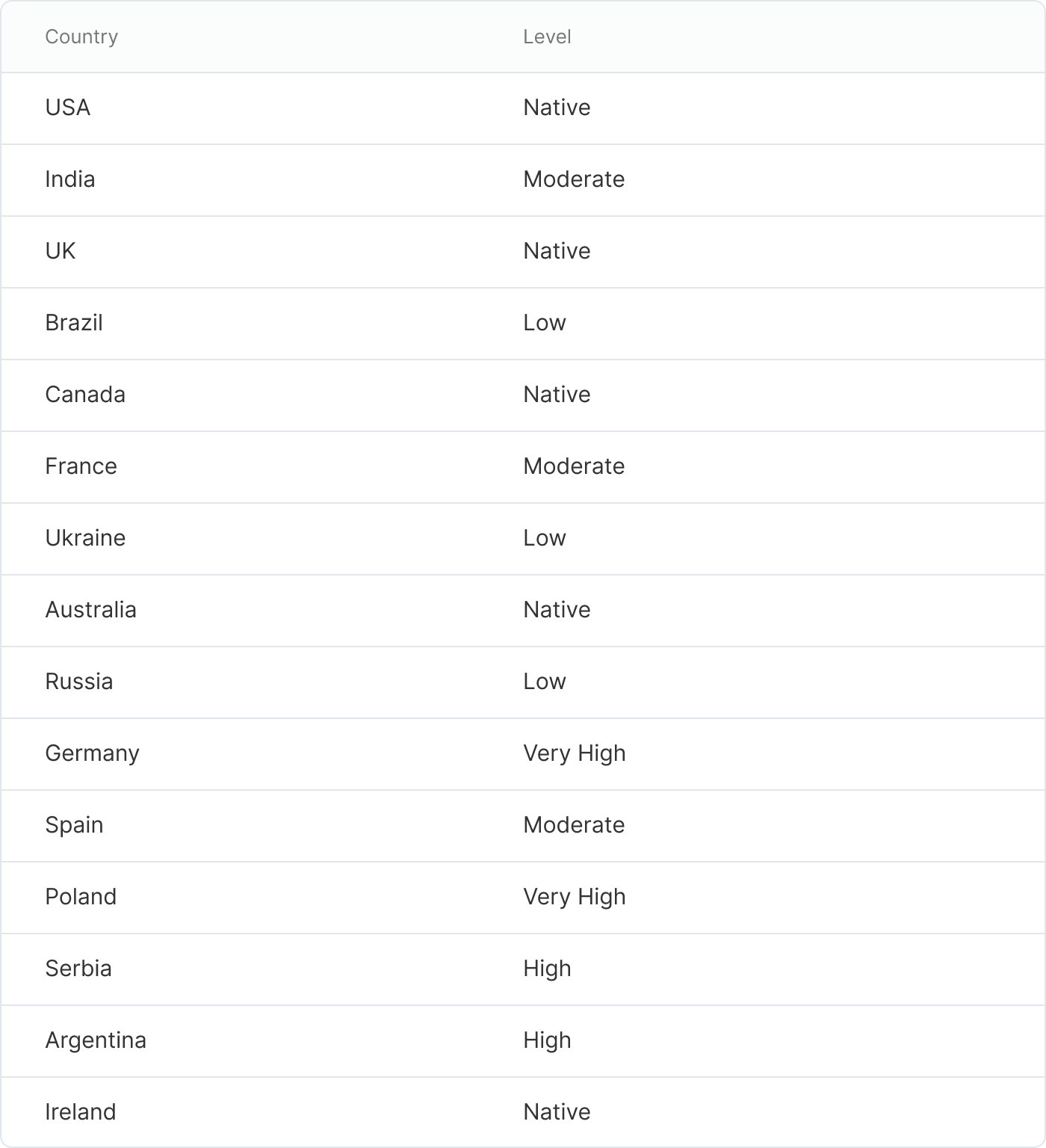

We made changes after we initially looked only for English speaking professionals. We realized that by using this qualifier we cut off a huge number of talented engineers. Then, we just hired tutors for these hires. Since all the communication in Slack and most of the verbal communication is in English, even those who had a zero level built up their level in just a couple of months.

You can put any artificial restrictions on hiring, but it makes sense to think about the pros and cons of each of them. It's necessary to understand that there are many engineers in the world, but there are few engineers who you can use that have both the skill set required as well as an interest in your tasks. This is already a pretty harsh filter.

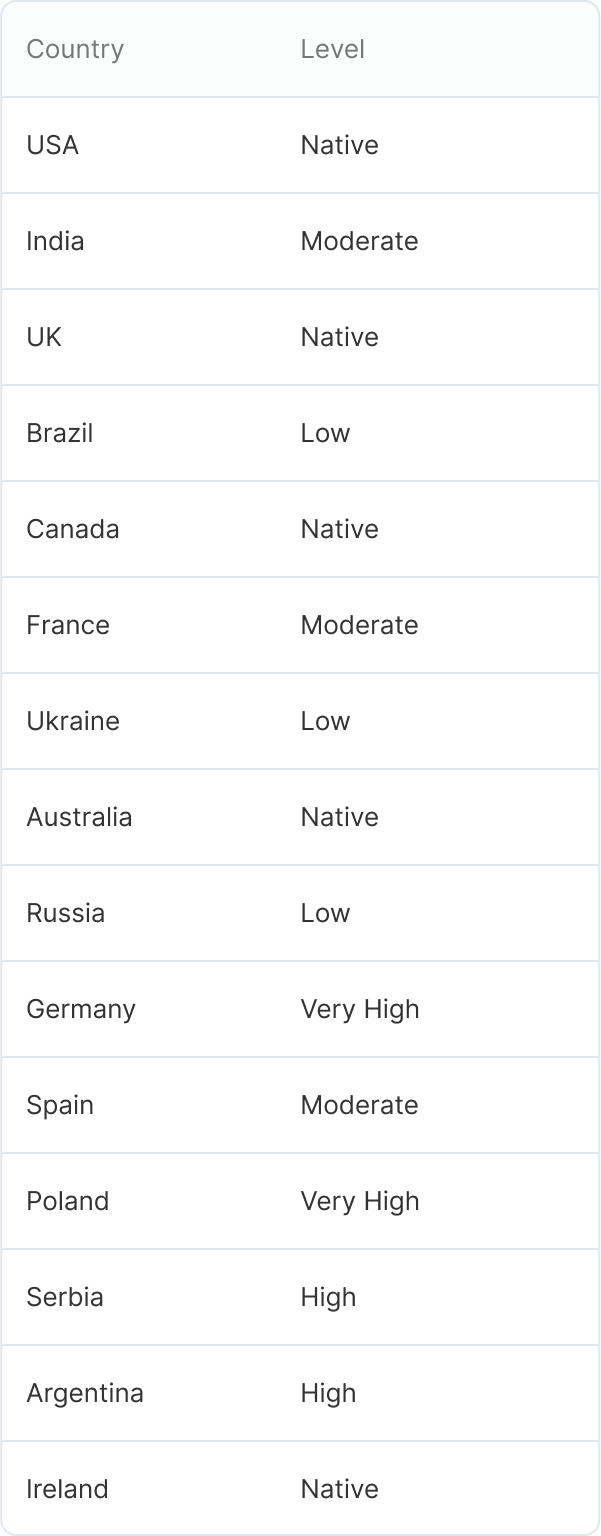
The origin of the company founder: Immigrants' hiring superpower
76% of the founders from the list live in the United States with 56.4% of the founders being American born. We determined their home countries by the founders' educational institutions (this information is easy to find in LinkedIn, unlike birthplaces). Immigrant founders are predictably more successful at hiring outside of the States.
E
Learn more about hiring outside the States in the last part of the research.
Through our platform and many interviews with founders, we are convinced that a big reason for this success is because they have a great advantage — another country, in which they know the language and the rules of the game.
It is quite logical that everyone first of all hires employees in the market they know best — Americans in America and Indians in India — in the country, where founders have their own network, understanding of the peculiarities of hiring and its legalities. This knowledge allows immigrants to hire people outside the USA confidently and bypass their competitors. They can hunt for talented heads in the regions, where such behemoths as Google, Facebook, and others rule.
For instance, New York startup Scentbird has proven its worth by biting off a share of the competitive American beauty market with an almost entire development team assembled of Russian-speaking guys. They do not have a language barrier problem, because the founders of the service are Russian. Attracting 43 serious developers to a beauty project was a serious challenge, which the founders coped with thanks to their network in CIS (post-soviet) countries. CherryHome, a Californian startup that produces a smart system for elderly care has a similar story.
However, even if you are American born, without the international contacts, this should not be an obstacle for truly global hiring, because now there are a lot of services that simplify the search and hiring of talented developers from all over the world. Today, it is just a matter of a few clicks to hire, sign a contract with, and pay an employee living outside the company's registered country.
of the founders are American born, and immigrants prefer to hire from their countries of origin

The competitive environment within the country
U.S. companies had about 918,000 unfilled IT jobs in the past three months reports The Wall Street Journal, using federal employment data analyzed by CompTIA, an IT trade association. This is a clear illustration of the competition for IT talent within the country. Hardly any other country can compare to the United States where the IT market has long been at the helm of talent, not employers.
F
The level of competition for specialists speaks volumes for the hiring side. If the competition is strong, it will be difficult and expensive to hire a specialist, if there is no competition at all, then most likely the IT market in the country is quite weak.
The idea of the level of maturity and competitiveness of the internal IT market can be formed on the basis of several indicators:
Presence of large local IT and Internet companies
To determine this you can refer to different ratings such as List of largest Internet companies.
To determine this you can refer to different ratings such as List of largest Internet companies.
Concentration of remote-jobs
The Whoishiring map clearly shows the highest сoncentration of remote-jobs in the USA, UK, Germany, and Poland, it is possible to assume, with great confidence, that it is extremely difficult to find specialists in these countries. If they have moved to mass remote hiring, it means that classic hiring has outlived its usefulness in the face of talent shortages.
The Whoishiring map clearly shows the highest сoncentration of remote-jobs in the USA, UK, Germany, and Poland, it is possible to assume, with great confidence, that it is extremely difficult to find specialists in these countries. If they have moved to mass remote hiring, it means that classic hiring has outlived its usefulness in the face of talent shortages.
Representation of branches and offices of world IT leaders in the country
If Facebook opens an office in an area, then there is a reason — there's a pool of developers. It also means that an IT culture has formed, because such companies not only form the demand and popularity of IT specializations, but also act as a school to develop young IT professionals.
If Facebook opens an office in an area, then there is a reason — there's a pool of developers. It also means that an IT culture has formed, because such companies not only form the demand and popularity of IT specializations, but also act as a school to develop young IT professionals.
Number of developers in the country
The current worldwide population of professional developers is about 23.9 million. Data by countries vary greatly from source to source, so we decided to specify the numbers according to LinkedIn registration by country. This data is partial but indicative and easy to check. We counted those who currently work as software developers, engineers, or data scientists with 3+ years experience.
The current worldwide population of professional developers is about 23.9 million. Data by countries vary greatly from source to source, so we decided to specify the numbers according to LinkedIn registration by country. This data is partial but indicative and easy to check. We counted those who currently work as software developers, engineers, or data scientists with 3+ years experience.
1
2
3
4


U.S. companies have about 918,000 unfilled IT jobs.

The highest concentrations of remote-jobs are in the USA, UK, Germany, and Poland.


We can not give an exact answer, just like we can't guarantee that you will become as successful as other companies. However, you can use the collected data to make a decision for yourself.
India & Bangladesh
Where should you hire from?
A
A big developer hub that can't be ignored (According to IDC, India's developer population will overtake the U.S. by 2023) and lower costs of living. These factors portend the popularity of outsourcing (Crossover, Universal Mind) in this region.
We grouped countries that are popular for hiring from by zones to make you comfortable in choosing a suitable hub for your goals and opportunities.
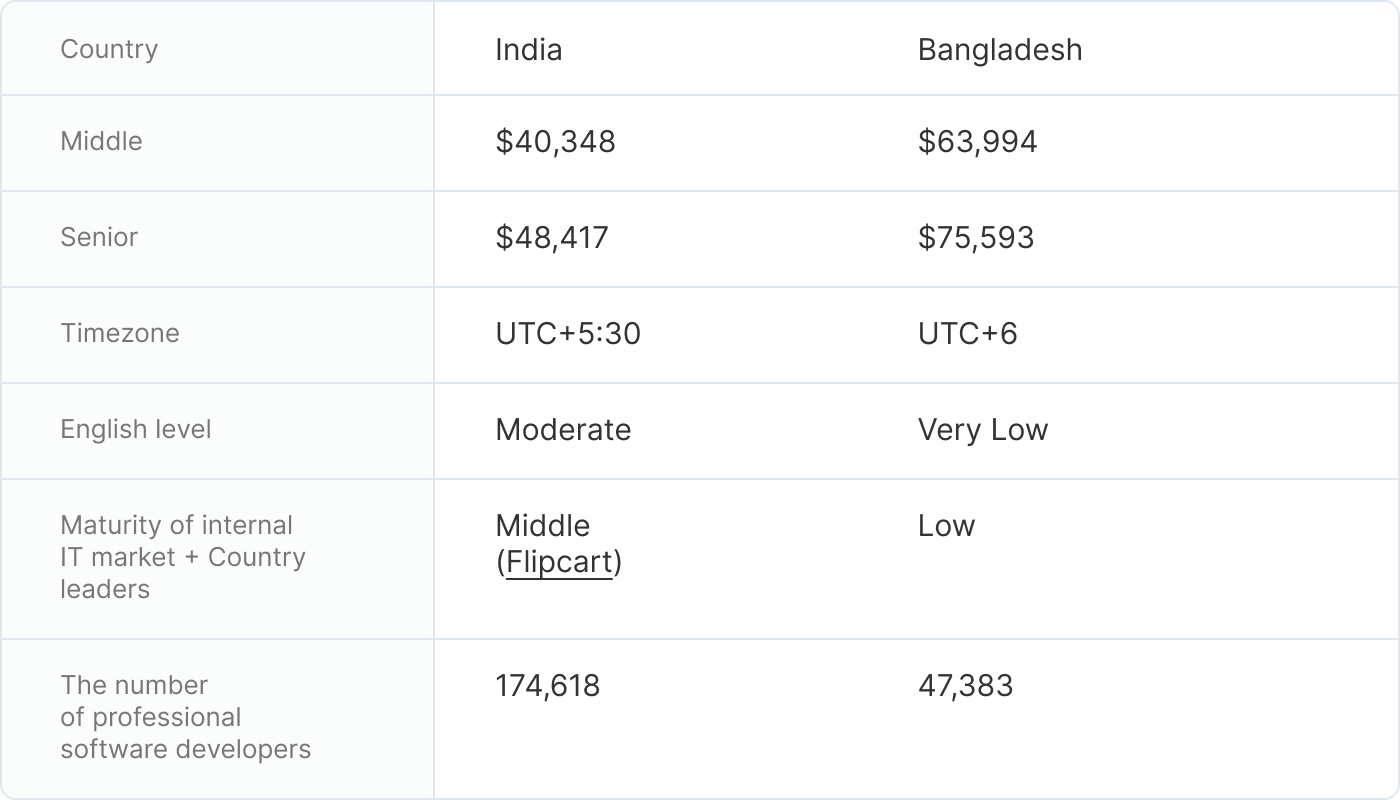
Companies hiring there
Mozilla engineer recruitment chart
GitHub engineer recruitment chart
Advantages
Crossover engineer recruitment chart
For synchronous operation, there is a big difference in time zones — it's 13 hours 30 minutes between San Francisco and Delhi.
Disadvantages
A huge advantage can be derived from the dispersal of a team across different time zones — to build processes so that the company works 24/7. Flexible hours for employees, the company can be productive non-stop — this is possible only in remote-companies with a large geography of hiring.
One group of the employees do their job, send work to colleagues for approval and review. When they start work the next day, they can see the result. This eliminates any waiting and hitches, processes moves faster, without wasting employee momentum.
We wanted to build a team that would function in different time zones. Our customers are also scattered around the world, and we want to ensure that they do not have to wait for product support. Having teams in different zones allows development to work almost 24/7.

CEO of DeckRobot
According to Stack Overflow findings, a lot of developers in India and Bangladesh actively looking for a job, but their average experience level is quite low — 2-3 years.
It means that you would hire in India if you are searching for a cost-effective solution and mass recruitment. But you need to have a strong CTO, team leads and build a good vetting process.

India's developer population will overtake the U.S. by 2023





Percentage of company employees hired in India and Bangladesh
Number of respondents
% of respondents who are actively looking for a job
Average years of professional programming experience
2,500
7,500
5,000


Western Europe: United Kingdom, Spain, Germany, France
The time difference between San Francisco and London is 8 hours, and this allows team calls, daily meetings: 6 pm for London is 10 am for San Francisco.
B
The founders of only 7 companies (Mattermost, Modern Tribe, Dribbble, DuckDuckGo, Bandcamp, RetailZipline, Stack Exchange) out of the 30 using a large percentage of Western European developers grew up in the United States. Which confirms our thesis about the correlation between the non-American origin of founders and hiring outside the States.
Advantages
Cultural proximity: сommon mentality and language obviously contribute to mutual understanding.
United Kingdom and Germany

France and Spain
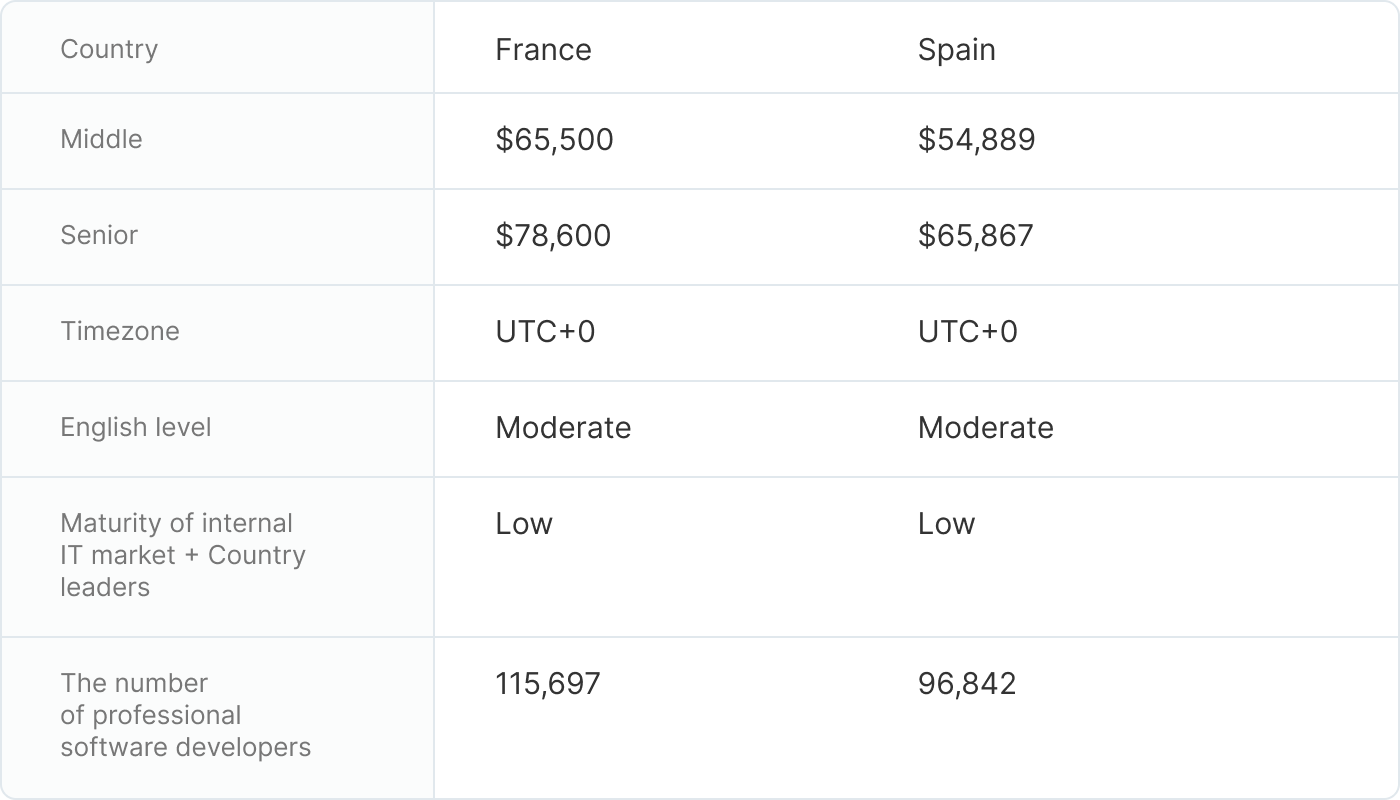
DataDog, the company with the French founders, engineer recruitment chart
Developers in the UK, Ireland, and Europe overall tend to have started coding younger than elsewhere in the world, in addition they have better management and communication skills.
Disadvantages
Not cost-effective compared to the rest of the world, but still cost-effective compared to US. High salaries in the UK affect remote hiring, overall the UK came in third place in hiring, no company is focusing hiring there, just selective hiring. High maturity of the market effects difficultness of finding an engineer here too.



Percentage of company employees hired in the UK, Spain, Germany, France




Latin America: Brazil & Argentina
C
Shared timezones with the US, low salaries relative to the US, low competition for talent within countries. As a consequence, a lot of outsourcing IT services like Toptal hire in Latin America.
According to Stack Overflow data, LATAM developers are more likely to work at the smallest companies, and are more likely to work at companies that do web development/design or IT (compared to North America and Europe, where more developers work at more diverse companies across the economy). And you can benefit from that.

LATAM developers are more likely to work at the smallest companies
Companies hiring there: оutsourcing companies like Clevertech, Toptal, product companies Xapo, Scrapinghub, Dribbble, Toggl.
Toggl engineer recruitment chart
Advantages
Toptal engineer recruitment chart

Low level of English, but as Mike Hansen, the founder of Sonatype, said in our interview, "Engineers are engineers", they will always understand each other. Mike, by the way, hires engineers in Colombia. Additionally, some countries in Latin America as Argentina have an English level comparable to Europe's.
Disadvantages
Latin American developers have an average of just over 5 years of professional coding experience. This is lower than regions such as North America or Europe, where the average is 10.




Percentage of company employees hired in Brazil and Argentina
Number of respondents
% of respondents who are actively looking for a job
Average years of professional programming experience
500
1,000
1,500


Eastern Europe: Russia, Ukraine, Poland, Serbia
Russia and Ukraine
D

Poland and Serbia

Common culture and close language throughout the post-Soviet space, still low competition for talent in Russia and Ukraine, low wages. That is why CIS countries are the foundation of major outsourcing centers for tech companies like HP, IBM, CISCO etc. So, there is no shortage of tech talent there.
Doist engineer recruitment chart
Cloudbeds engineer recruitment chart
DataRobot engineer recruitment chart
Advantages
Toptal hire in Eastern Europe (Serbia, Russia, Croatia, Poland, Romania, Ukraine etc.) a lot.
X-team engineer recruitment chart
All these countries pride themselves on good education, great knowledge, and their ability to produce quality code. As such, outsourcing companies use and sell development services from Eastern Europe to you. So, why not hire the same strong engineers and make them part of your team?
Russia’s size means that it covers many time zones — from UTC+1 to UTC+12. If you want your engineering team to work 24/7 — hire from Warsaw to Yekaterinburg. If you want the development team to be in the same time zone and cultural context — limit the hiring to Eastern Europe.
The Philippines and India offer lower rates, but Eastern European countries are also attractive for those who are looking for a smaller time difference and regular communication.
Disadvantages
There is high competition for talent in some Eastern European countries. CIS countries are not perceived as IT hubs, because few people know that IT companies like EPAM Systems, Wargaming, and Viber are Belarusian and accumulate a large number of talent.
According to data from English First (EF), Russia and Ukraine are among the countries with Low Proficiency in English. On the contrary, we have three arguments:
the study was not conducted among developers, and as our interviews show, English levels are much higher amongst those in the IT field than across the general population;
if you hire only in Eastern Europe, problems with communication between developers do not arise as there is no linguistic or cultural barrier;
and let's not forget "Engineers are engineers".

Out of the 13.730 job applications we received at @Doist since 30th Nov 2016, we only hired 18 people (0.13%) (An interesting stat by @Zjellstrom).
— Amir Salihefendić (@amix3k) November 30, 2017
This is one of the great things about remote-first: the pool of job applicants is vast since it covers the whole world.





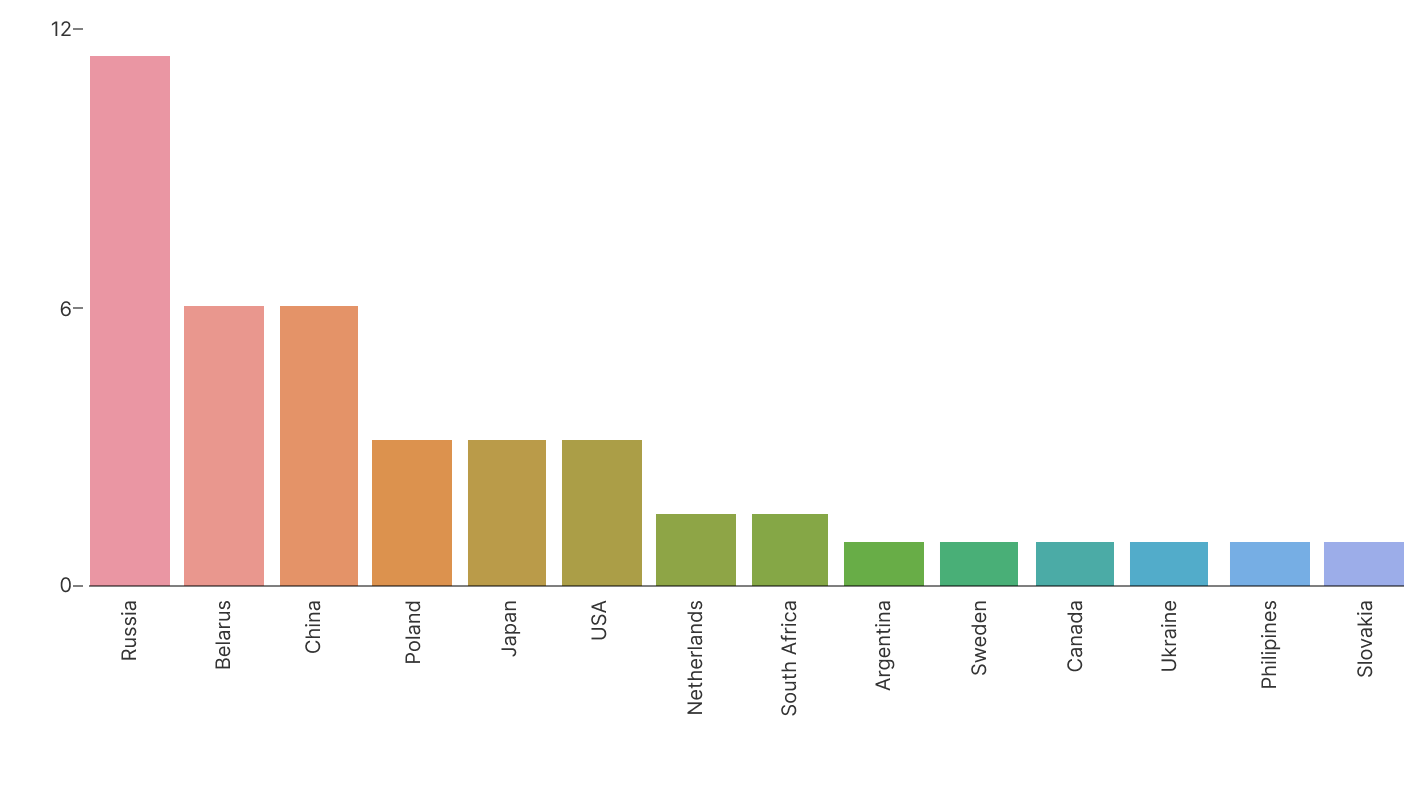

Percentage of company employees hired in Russia, Ukraine, Poland, Serbia
Total number of medals on Google Code Jam since 2003
Average monthly base salary of a software engineer in the leading Russian internet companies is almost 5x lower vs. US.
Average monthly base salary of a software engineer ex. bonuses, USD'000 (Glassdoor):

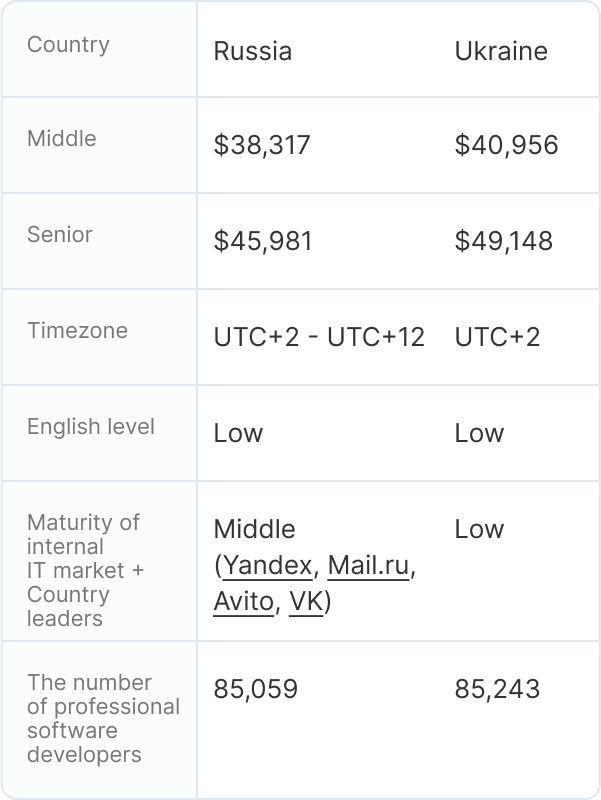

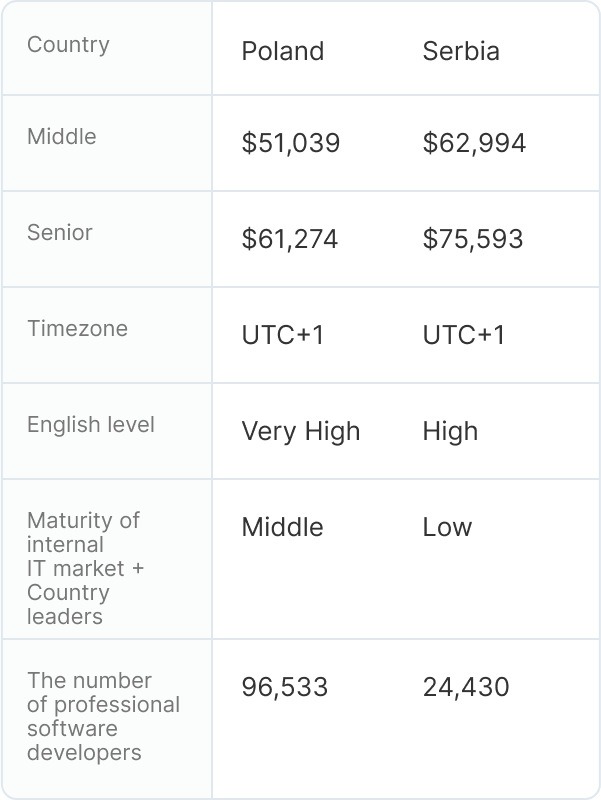
How to legally hire remote employees outside USA?
How to deal with the legal aspect of hiring from abroad, you decide for yourself. We will only give two opinions, two ways to solve this issue. Though, there is no other way. Hire full-time employees or hire full-time contractors. That is all. We certainly don't consider freelancing or outsourcing and do not advise you to do it.
Full-time employee vs. Contractor
Full-time employee
A
Although it's relatively easy to find great people when you're able to hire from anywhere, employing them is not.
Most organizations start by employing people in other countries (than their HQ) as contractors or freelancers. However, if you want to hire someone, and they’ll contribute and are treated in all ways as any other employee — it’s most likely that you need to offer them a local, formal employment. Not doing so will put the employer at compliance risk (misclassification), and tends to burden the employee with additional paperwork and taxes. It’s also unlikely that you’re able to offer the employee (similar) benefits, if at all. Lastly, the employee might feel like they’re second-rate, in comparison with their fully employed colleagues.
Employment works differently for each country. That means that if you want to employ people directly, you will need to learn the laws for each country. You need to comply with local labor laws, take care of payroll and taxes, and establish an entity in that country. If this sounds unreasonable, you’ve heard it well. It’s expensive and complex to do this in one country, let alone in multiple.
Luckily, there are solutions. If you hire people in one other country only, you can use a local company to help you out with your needs. PEO’s or employer-of-record companies employ people for you locally and take care of payroll and compliance issues. You pay a fee on top of costs. These vary wildly in quality and accessibility for foreign companies and tend to be rather expensive. If you hire many (fifty or more) people in a single jurisdiction, it’s probably worth to establish an entity there.
Nowadays there are global employers of record, such as Remote. These companies offer a similar model to local PEOs / EORs, but with a presence in many countries. That means you can employ your entire team through one of these companies, and have a single point of contact for anything related to the payroll, etc, of your employees.
Using a global employer of record can be a perfect solution, but pay attention to:
Pricing transparency: if it's not clear what you're paying for, you're probably paying too much.
Ownership of local entities: the global EOR should own all entities locally, and be in tight control of them. If that's not the case, your employees might be locally employed by a third-party that can't be trusted, is hard to work with, or otherwise problematic.
Accessibility: employment is complicated. It should be easy to get in touch, and check up on the status of payroll of your employees, even when employed through a global EOR.
If you’re just starting out, hiring people as contractors is quick and easy. But for long-term employment, this is not a solution.


Contractor
B
This is a step-by-step plan for those who want to hire the best, but are forced to optimize expenses to pay these specialists and understand that it is worth looking outside the US (brofist to all the daredevils).

Disclaimer
IRS procedures can be subject to change, so before you submit the forms, please check for the newest updates on www.irs.gov
In order to officiate a contractor (also called consultants) you'll need to sign:
A description of consulting services aka Scope of Work and payment terms.
Confidential Information and Invention Assignment Agreement to protect intellectual property. This should get rid of any misconceptions that the company is defenseless against theft by remote, foreign workers. That idea is, of course, false. No one in the IT industry would even consider working if there were a risk of losing everything at any moment.
For $ 19 on Clerky, a service that helps create and sign agreements, you could be confident in the fact that they will protect your needs and interests.
Step 1
Find a professional who is equal to, if not better than, one from the Valley (we know it may be hard for many Americans to believe). The world is huge, and there are a lot of IT giants in America, yet only 5% of the population lives there: talent is distributed equally around the world, opportunities are not. Also, a non-American remote worker's pay will not include the "Valley markup" (about $ 60−110k a year).
Why is it that there are so many startups, so many important technical products in San-Francisco, in Silicon Valley, when compared to other places? It can’t be that people are simply smarter or more talented here — there are just as many engineers, designers, and product-people in Mexico, even more in Moscow.

Phil Libin
CEO Evernote
Step 2
Since, in this case, we're talking about an employee who is not a US citizen, then it's better to treat them as a contractor. This way, you won't be faced with barriers like them moving to another country, bureaucratic delays, visa unpredictability, etc.
Step 3
Without filling out this form, or if the contractor's country does not have a tax treaty with the US, the contractor will have to pay a 30% tax.
You can follow these steps or use a service such as Deel, which will fill out and submit all of the documents for you automatically when starting a new contract.
You can hire as you see fit. But you need to understand that the official employment of a foreigner in an American company is at least expensive and, if you do it yourself, long and painful for both your business and for the employee, who will require endless amounts of paper and documents. We find that the developers see it as easier, they do not mind being contractors and do not consider themselves in this case non-core members of the team; they can feel confident and just use the opportunity to work on an interesting project and team wherever they are.
It seems that developers are ahead of employers, both in their willingness to work remotely and in their willingness to ignore extra bureaucracy.
As for formalities, I work as a contractor. This is a standard practice in startups employing specialists from all over the world. I don’t see any drawbacks in this yet. I don’t aspire to any social packages and so on, you better pay me more, and I will solve the issue of insurance, hospitalization and how many teeth to treat per year.

React developer from Moscow
I understand that I may be fired one day, that the project may close down, or that for some technical reasons they may not be able to continue working with me, but it does not bother me, I will find a job. It's hard to find good developers today.


Bonus: Portrait of a remote developer
After we compiled our research, we tried to use it to create a "portrait" of a remote developer. We analyzed the profiles of employees of the companies from the list and found that the average age of technical specialists is 34.3 years, 83% of them are men, 17% are women.
of engineers from established remote companies studied in the top-100 universities

As for education, it should be noted that there has been an ongoing trend of not attaching importance to higher education and to base hiring decisions only on the skills of the candidate. However, the distribution of educational levels completed was as follows:
Certainly, it is not that rare to find accomplished professional developers who have not completed a degree (Stack Overflow has insights here).
Digging a little deeper, we analyzed the universities where the developers from our sample studied. We ranked the universities from 1 to 800, where 1 means a top university, and the closer to 800, the lower the recognition.
It turned out that there is no obvious indicator here: both graduates of prestigious universities and those who attended lesser-known institutions work in remote companies.
For the skeptics out there, who believe that remote work is suitable just for unskilled non-core staff, here is a worthwhile statistic: 23% of engineers from established remote companies studied in the top-100 universities.



Number of people x The University Rank, where 1 means a top university
Number of people x Age
Among the developers of these companies, there are those who have dropped out of university or have never even attended. We, unfortunately, are unable to extract and display this data.
Conclusion
58.6% of the employees of the "Established Remote Companies" are hired from outside the USA.
This means that there will always be a lack of talent and there will always be strong competition for programming brains. With these conditions and giants like Google and Facebook, headhunting is especially difficult for young, still noname startups.
Even as a young small startup, you, too, can work as the most successful companies on the list do right now. Become remote now to become a billion-dollar company later.
Good luck and good hiring!
There are 3 357 626 'Strict' Developers in The United States and largest tech market in the world, representing 32% of the total.
Remote jobs are still incomparably less costly than office jobs. Job listings that allow telecommuting receive 250% more applications on average. Developers prefer freedom and flexibility in their work schedule and consider the ability to work remotely at the top of their perks when choosing among proposals. This is your fat competitive plus, which can be purchased for only $ 0 and a bit of courage!
In addition to the fact that hiring remote employees gives you the opportunity to build a strong team in a shortage of funds at the start of the product, it will also allow you to quickly bring the project to the ramen profitable level, and this is an extremely important stage while trying to reach a designated cash value on "Who Wants to Be a Millionaire?".
6nomads blog

For talents
Find a full-time remote job in a tech company
6nomads is a remote-focused
job platform for tech talent. Create a profile
and let companies apply to you.
job platform for tech talent. Create a profile
and let companies apply to you.
For employers
Hire top engineers from all over the world
We match distributed teams
with relevant remote individuals.
with relevant remote individuals.

2019, 6nomads © Copyright
Keep in touch
To get updates on this research, new posts on our blog and promo codes for job posting, leave your email below.









